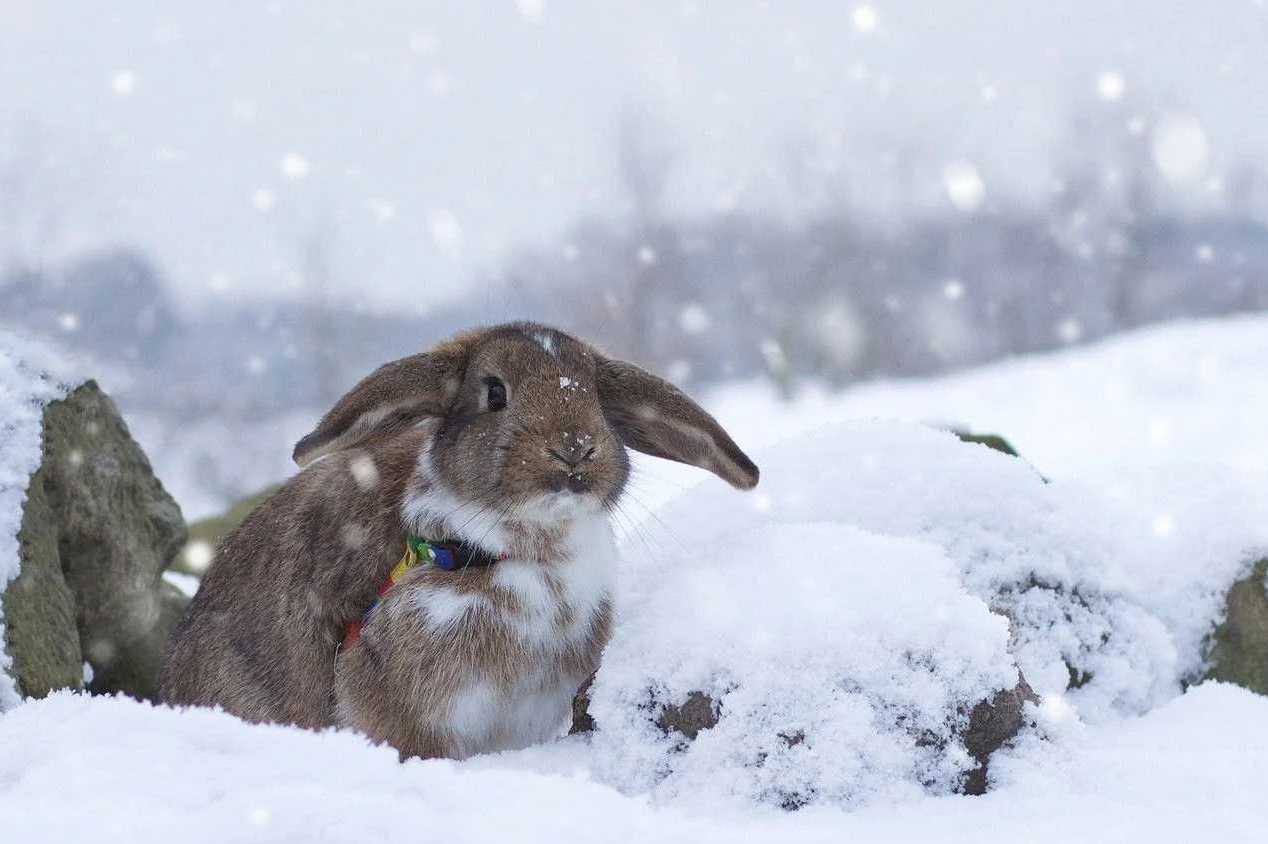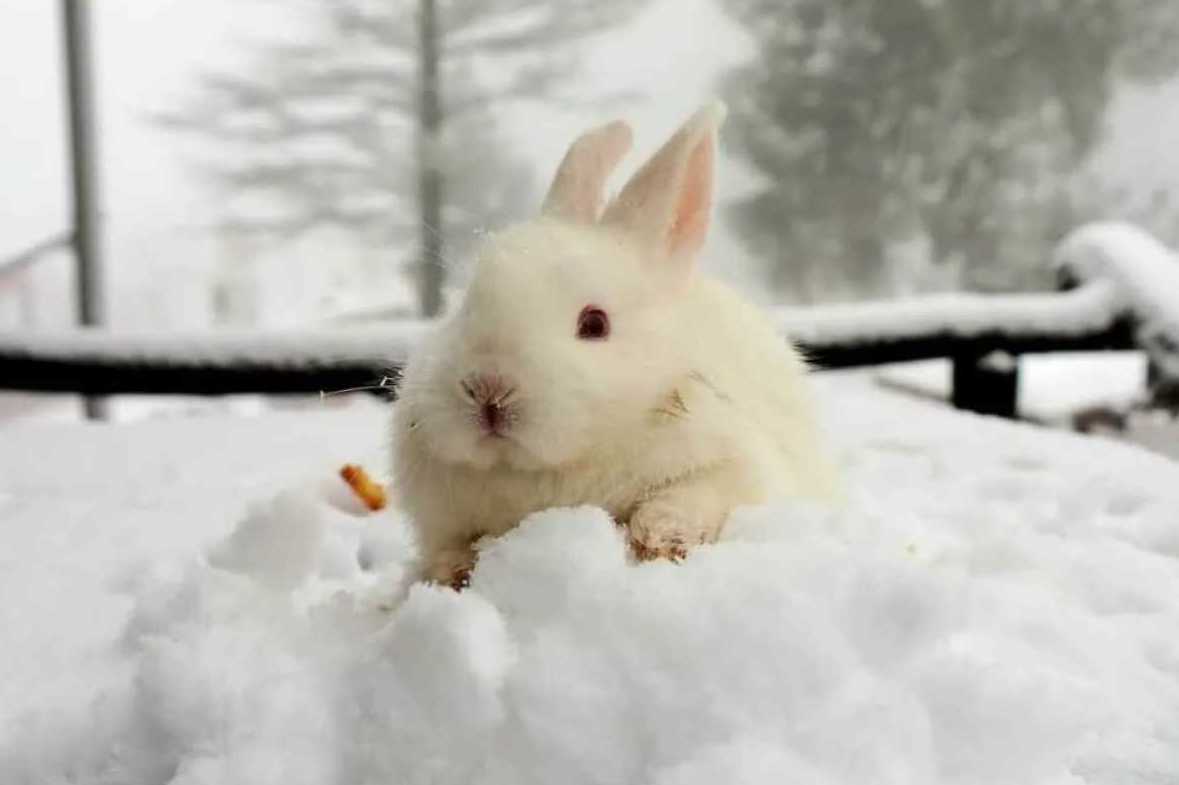If you want to have a pet bunny that you would keep outside, you may wonder whether rabbits are equipped to withstand cold temperatures during winter.
You will find out all about it in this article, so keep reading to learn everything you need to know about bunnies and the temperatures that suit them the most.
How Much Cold Can Rabbits Withstand?

Rabbits are resilient animals – they can withstand temperatures as low as 30°F (-2° C). Bunnies are generally acclimated to different weather conditions, including freezing temperatures. T
heir hardiness makes it possible for you to keep them outside all year long, including the winter months. Their fur does a great job keeping them warm, apart from making them irresistibly cute.
Rabbits’ thermoregulation is different from humans and some other animals in a way that rabbits don’t sweat. Instead, they control their body temperature through breathing and with the help of their ears.
What Happens To Rabbits If They Get Too Cold?
While rabbits are quite adapted to cold temperatures, you shouldn’t leave them outside without appropriate bedding or a heating lamp. If the temperature is below 30°F for too long they can develop frostbites, and in more severe cases, they could die of hypothermia.
If your bunny is living outside, you should be checking for signs that can help you determine whether your pet is too cold. One of the first signs is shivering, which is an automatic response of a body that implies rapid muscle movements with the goal of providing immediate heat.
Shivering can’t provide enough heat if it is too cold outside, so if you see your rabbit shaking, you should take action to help your pet warm up right away.
Cover your bunny with a blanket or turn on a heating lamp. You can consider taking your bunny in for the time being until you’re sure that the temperatures outside are safe for it to come back.
Shivering isn’t dangerous, but frostbites can be risky and painful for your rabbit. Your bunny may develop frostbites on the ears and toes, so check these areas first.
Frostbites can cause a part of the skin or body to fall off because there isn’t circulation in that area because of the freezing temperatures. They can also cause infections and, if left untreated, death.
You should take proper care of your rabbit during winter so this doesn’t happen, but if you notice frostbites on your bunny, take it to a vet immediately after wrapping your pet in a warm blanket.
Rabbits During Winter
Keeping a rabbit outside during the spring, summer, and autumn months doesn’t require special care.
However, keeping them in your yard during winter comes with a few adjustments you should make for your pet. Let’s see what are some things you need to know about rabbits in winter.
What Do Rabbits Do During Winter?

Wild rabbits do not hibernate during winter, so they spend a lot of their time either searching for food or sleeping. The vegetation during winter is scarce, but there are still plants available for rabbits to eat, such as grass.
If they are in a food or vitamin deficiency, they tend to eat their feces. Rabbits in the wild also spend time finding a shelter that is secluded and warm enough to keep their body temperature stable.
They usually find shelter where other animals cannot see them, such as in bushes, hollow trees, and even yards.
When it comes to pet rabbits, they don’t need to do all of these things because you provide food and shelter to them. If it is freezing outside and you don’t spend enough time with your pet, your bunny can feel bored and lethargic because of the lack of activities available in their shed.
This is why you need to either spend time with your bunny every day for a few hours and provide them with fun and exciting things to do while you are away.
What Do Rabbits Eat During Winter?
During winter, wild rabbits eat what they find; they cannot be too picky because they lack fresh fruits and veggies. They need to eat whatever survives during winter, and that’s mostly grass.
You should adjust your bunny’s diet according to your vet’s advice. If you keep your bunny outside, you may need to increase the calories you feed your pet because they require more energy to stay warm.
You should increase the amount of food you feed your rabbit only after consulting a professional because you don’t want to overfeed your rabbit and risk the diseases that come with a chubby bunny. Your pet may also need more physical activity during the winter months.
Rabbit Special Care During Winter

If your rabbit lives in your home with you, you shouldn’t do anything out of the ordinary during the winter months. Humans’ and rabbits’ body temperature is similar, so if you are warm, your pet is comfortable too.
However, if you keep your rabbit outside, there are a few things you should be prepared to do for your furry little pet. Here they are.
Isolation And Insulation
Winter doesn’t only imply cold weather but a lot of precipitation and strong winds as well. Your bunny’s shed should be adequately isolated from rain, snow, and wind.
Getting wet while cold increases your pet’s chances for frostbites and hypothermia, and adding a strong, cold wind to that equation puts your bunny in even greater danger.
The shed should be thick and sturdy – apart from isolating your pet from bad weather conditions, you should also make sure no predator can reach and enter the shed.
You should also keep your rabbit warm. While rabbits tolerate cold weather well enough, they shouldn’t get too cold or stay in the freezing temperatures for too long. It would help if you changed your pet’s bedding regularly, and it should be dry at all times.
A good choice for bedding is hay, but you can also throw some cozy blankets there.
Consider installing a heating lamp if you live in a cold area; you will need to make sure your rabbit can’t reach it, but it is an excellent choice for keeping your bunny warm and comfortable during the winter months.
Your pet’s water will freeze if the temperatures are below 32°F (0°C). You may not even notice it, and your bunny can get dehydrated in the meantime.
This is why you should change the water frequently – every few hours at least. If you are not available to do that, you can insulate the water bottle by wrapping a woolen piece of fabric or bubble wrap around it.
Provide Playtime

Playtime is an essential part of a rabbit’s daily routine. It helps your pet stay entertained and burns off extra calories, so your bunny doesn’t get overweight.
It’s easy to provide your bunny with various activities during the summer months, but what about winter?
One of the options is to let your bunny stay inside your home for a few hours every day. You and your household members can cuddle and play with your pet, so it doesn’t get lonely and bored.
If you are not in a situation to do this, you can buy several bunny toys and put them in your pet’s shed so they can play whenever they want.
Some rabbits like to play in the snow, and I promise you, it can be as entertaining for you as it is for them. When you have some time during the day, let your pet outside and watch them enjoy rolling in the snow.
Ensure that they are dry before going back to their shed, and don’t forget to close it during the night to protect your pet from potential predators.
Consider Getting Your Rabbit Company
If your rabbit is living alone outside, you should consider adding a bunny or two to your family. Rabbits like company, and being with friends can make them happier.
They also like to snuggle together when it’s cold, so you won’t have to worry about your rabbit freezing during the night.
What Temperatures Are Ideal For Rabbits?

Rabbits do well in temperatures that range from 50°F to 70°F (10°C to 21°C). These are average temperatures during the spring and autumn months in most places, but summers and winters can get pretty extreme, depending on where you live.
If you are not sure whether your bunny is comfortable, check its body temperature. It should be 101°F to 103°F (38°C to 39°C).
What Happens If A Rabbit Gets Too Hot?
Hot weather can be as dangerous to rabbits as extremely cold temperatures. If your rabbit gets too hot, it can experience a heatstroke, which can be fatal. Some signs to look for are shortness of breath, sluggish behavior, prolonged inactivity, and drooling.
If this happens, you should bring your pet to a cooler place. If your air conditioner is off, turn it on and let the room cool down. Dampen a clean towel with cold water and pat your rabbit’s fur. If the symptoms continue, take your bunny to a vet for further care.
Summary
Rabbits can tolerate cold weather well, and they do okay even in freezing temperatures, provided they are not wet or on the wind. If you keep your rabbit outside, provide it with a good, secure shelter, plenty of food, fresh liquid water, and maybe even a friend or two.